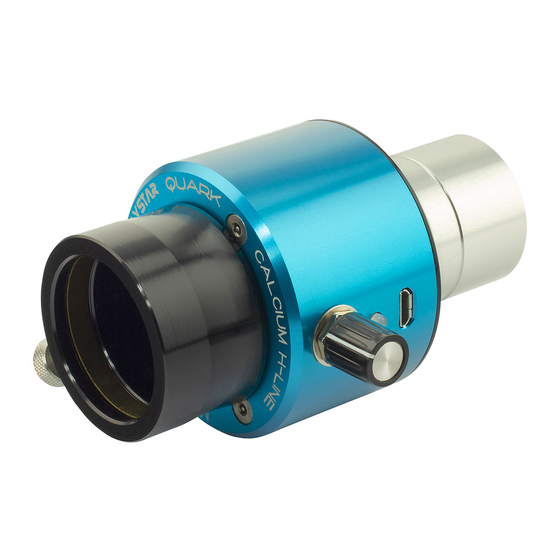DayStar Filters CALCIUM QUARK Manual - Page 5
Browse online or download pdf Manual for Accessories DayStar Filters CALCIUM QUARK. DayStar Filters CALCIUM QUARK 17 pages.

Observing with over 150mm of aperture requires consideration of
multiple factors, please consult with DayStar for advice specific to your
situation.
Calcium H versus Calcium K:
Traditionally, university research has employed the Calcium K line for
studies of Calcium on the Sun. These studies have been instrumental in
determining depth of the solar atmosphere. Calcium offers TWO strong
absorption lines at 393.3nm and at 396.9nm, known as the K and H
lines. Researchers originally avoided the H line for academic research,
as it is very close to the Hydrogen Epsilon line.
However, as the visual spectrum ends at approximately 400nm, the
further we venture below this wavelength the more difficult it is for
observers to visually see the image. For visual observations the H line is
closer to the visual spectrum and easier to see in high contrast violet
color while offering the same features as K line. We have found many
older viewers are able to see H visually when they cannot see K. For
imagers,
H
offers
improved
quantum
efficiency,
higher
glass
transmission, and superior performance from typical antireflection
coatings. H line offers slightly more visible features due to the Hydrogen
contribution. For strong wing shifts, H offers spectroscopically cleaner
wings than K, simplifying data interpretation at H. Stunning images from
the Hinode spacecraft and Dutch Open Telescope have further
popularized the H line in recent years. For all of these reasons, we are
offering the Calcium Quark in H line.
How it works:
Light from the telescope enters the blocking filter, where wavelengths
near Calcium H are transmitted while the rest are reflected back out.
Violet Calcium H light then passes through the Etalon.
The Etalon
passes a very narrow range of light wavelengths, but it is sensitive to
temperature and light angle.
In the Quark, the Etalon is heated to
approximately 100-150° F to control the wavelength p assed, and the slow
focal ratio of the telescope controls the angle of light entering the Etalon.
